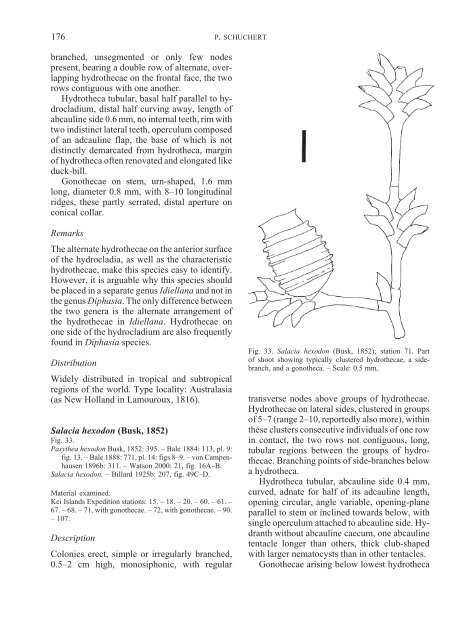Hydroids (Cnidaria, Hydrozoa) of the Danish expedition to
Hydroids (Cnidaria, Hydrozoa) of the Danish expedition to
Hydroids (Cnidaria, Hydrozoa) of the Danish expedition to
You also want an ePaper? Increase the reach of your titles
YUMPU automatically turns print PDFs into web optimized ePapers that Google loves.
176<br />
branched, unsegmented or only few nodes<br />
present, bearing a double row <strong>of</strong> alternate, overlapping<br />
hydro<strong>the</strong>cae on <strong>the</strong> frontal face, <strong>the</strong> two<br />
rows contiguous with one ano<strong>the</strong>r.<br />
Hydro<strong>the</strong>ca tubular, basal half parallel <strong>to</strong> hydrocladium,<br />
distal half curving away, length <strong>of</strong><br />
abcauline side 0.6 mm, no internal teeth, rim with<br />
two indistinct lateral teeth, operculum composed<br />
<strong>of</strong> an adcauline flap, <strong>the</strong> base <strong>of</strong> which is not<br />
distinctly demarcated from hydro<strong>the</strong>ca, margin<br />
<strong>of</strong> hydro<strong>the</strong>ca <strong>of</strong>ten renovated and elongated like<br />
duck-bill.<br />
Gono<strong>the</strong>cae on stem, urn-shaped, 1.6 mm<br />
long, diameter 0.8 mm, with 8–10 longitudinal<br />
ridges, <strong>the</strong>se partly serrated, distal aperture on<br />
conical collar.<br />
Remarks<br />
The alternate hydro<strong>the</strong>cae on <strong>the</strong> anterior surface<br />
<strong>of</strong> <strong>the</strong> hydrocladia, as well as <strong>the</strong> characteristic<br />
hydro<strong>the</strong>cae, make this species easy <strong>to</strong> identify.<br />
However, it is arguable why this species should<br />
be placed in a separate genus Idiellana and not in<br />
<strong>the</strong> genus Diphasia. The only difference between<br />
<strong>the</strong> two genera is <strong>the</strong> alternate arrangement <strong>of</strong><br />
<strong>the</strong> hydro<strong>the</strong>cae in Idiellana. Hydro<strong>the</strong>cae on<br />
one side <strong>of</strong> <strong>the</strong> hydrocladium are also frequently<br />
found in Diphasia species.<br />
Distribution<br />
Widely distributed in tropical and subtropical<br />
regions <strong>of</strong> <strong>the</strong> world. Type locality: Australasia<br />
(as New Holland in Lamouroux, 1816).<br />
Salacia hexodon (Busk, 1852)<br />
Fig. 33.<br />
Pasy<strong>the</strong>a hexodon Busk, 1852: 395. – Bale 1884: 113, pl. 9:<br />
fig. 13. – Bale 1888: 771, pl. 14: figs 8–9. – von Campenhausen<br />
1896b: 311. – Watson 2000: 21, fig. 16A–B.<br />
Salacia hexodon. – Billard 1925b: 207, fig. 49C–D.<br />
Material examined:<br />
Kei Islands Expedition stations: 15. – 18. – 20. – 60. – 61. –<br />
67. – 68. – 71, with gono<strong>the</strong>cae. – 72, with gono<strong>the</strong>cae. – 90.<br />
– 107.<br />
Description<br />
Colonies erect, simple or irregularly branched,<br />
0.5–2 cm high, monosiphonic, with regular<br />
P. SCHUCHERT<br />
Fig. 33. Salacia hexodon (Busk, 1852); station 71. Part<br />
<strong>of</strong> shoot showing typically clustered hydro<strong>the</strong>cae, a sidebranch,<br />
and a gono<strong>the</strong>ca. – Scale: 0.5 mm.<br />
transverse nodes above groups <strong>of</strong> hydro<strong>the</strong>cae.<br />
Hydro<strong>the</strong>cae on lateral sides, clustered in groups<br />
<strong>of</strong> 5–7 (range 2–10, reportedly also more), within<br />
<strong>the</strong>se clusters consecutive individuals <strong>of</strong> one row<br />
in contact, <strong>the</strong> two rows not contiguous, long,<br />
tubular regions between <strong>the</strong> groups <strong>of</strong> hydro<strong>the</strong>cae.<br />
Branching points <strong>of</strong> side-branches below<br />
a hydro<strong>the</strong>ca.<br />
Hydro<strong>the</strong>ca tubular, abcauline side 0.4 mm,<br />
curved, adnate for half <strong>of</strong> its adcauline length,<br />
opening circular, angle variable, opening-plane<br />
parallel <strong>to</strong> stem or inclined <strong>to</strong>wards below, with<br />
single operculum attached <strong>to</strong> abcauline side. Hydranth<br />
without abcauline caecum, one abcauline<br />
tentacle longer than o<strong>the</strong>rs, thick club-shaped<br />
with larger nema<strong>to</strong>cysts than in o<strong>the</strong>r tentacles.<br />
Gono<strong>the</strong>cae arising below lowest hydro<strong>the</strong>ca

















